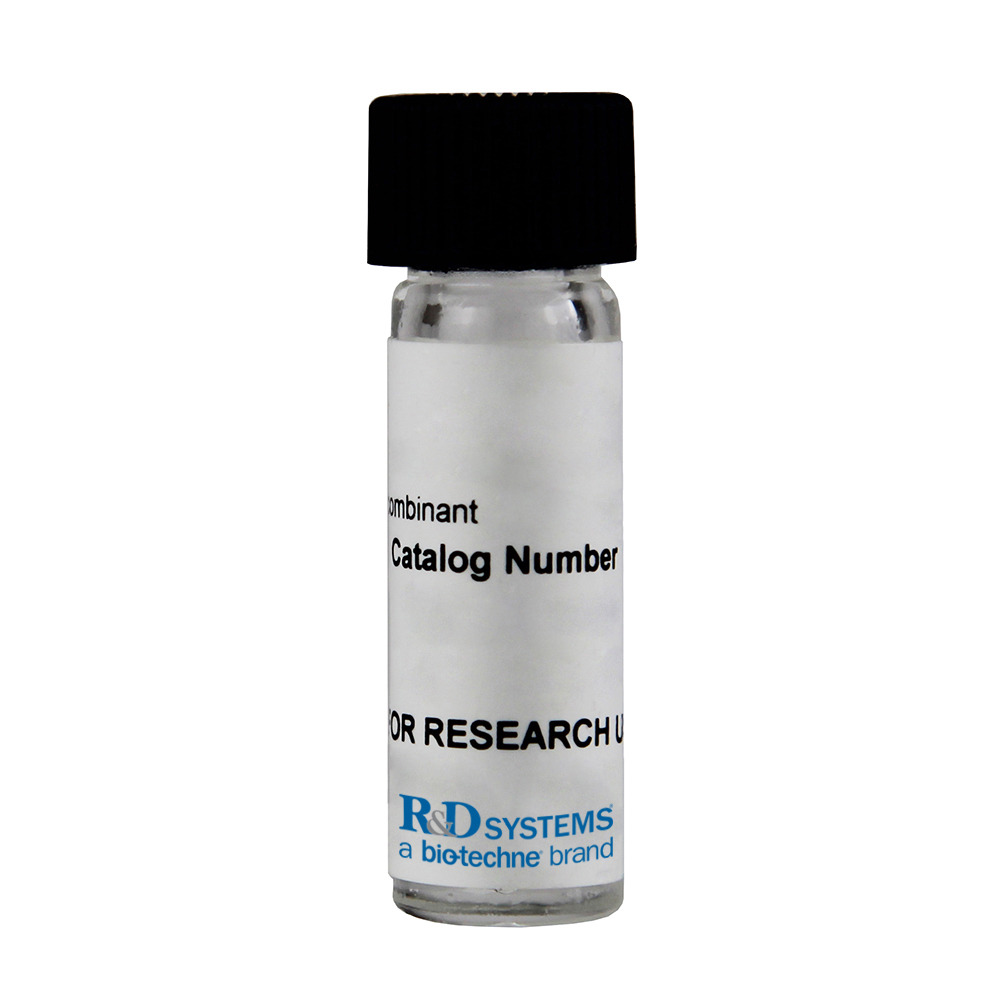Recombinant Mouse ADAMTS1 Protein, CF Summary
Product Specifications
Phe254-Cys725, with a C-terminal 10-His tag
Analysis
Product Datasheets
5867-AD
Carrier Free
CF stands for Carrier Free (CF). We typically add Bovine Serum Albumin (BSA) as a carrier protein to our recombinant proteins. Adding a carrier protein enhances protein stability, increases shelf-life, and allows the recombinant protein to be stored at a more dilute concentration. The carrier free version does not contain BSA.
In general, we advise purchasing the recombinant protein with BSA for use in cell or tissue culture, or as an ELISA standard. In contrast, the carrier free protein is recommended for applications, in which the presence of BSA could interfere.
5867-AD
| Formulation | Supplied as a 0.2 μm filtered solution in Sodium Acetate, CaCl2 and NaCl. |
| Shipping | The product is shipped with polar packs. Upon receipt, store it immediately at the temperature recommended below. |
| Stability & Storage: | Use a manual defrost freezer and avoid repeated freeze-thaw cycles.
|
Assay Procedure
- Assay Buffer: 25 mM HEPES, 0.01% (w/v) Brij-35, pH 7.0
- Recombinant Human Aggrecan Aggrecan G1-IGD-G2 Domains (rhAggrecan) (Catalog # 1220-PG)
- Recombinant Mouse ADAMTS1 Recombinant Mouse ADAMTS1 (rmADAMTS1) (Catalog # 5867-AD)
- SDS-PAGE and/or Western blot
- Dilute rhAggrecan to 200 µg/mL in Assay Buffer.
- Dilute rmADAMTS1 to 20 µg/mL in Assay Buffer.
- Combine 25 µL of 200 µg/mL rhAggrecan with 25 µL of 20 µg/mL rmADAMTS1 in a reaction tube.
- Incubate the reaction mixture for 24 hours at 37 °C.
- For Controls: Combine 25 µL of rhAggrecan solution and 25 µL of Assay Buffer into two tubes. Incubate one tube at 37 °C and the other at -20 °C for 24 hours.
- Stop the reaction by adding reduced SDS-PAGE sample buffer.
- Analyze the cleavage by SDS PAGE followed by protein staining and/or Western blot.
- rmADAMTS1: 10 µg/mL (0.5 µg)
- rhAggrecan: 100 µg/mL (5 µg)
Background: ADAMTS1
ADAMTS1 (a disintegrin and metalloproteinase with thrombospondin motifs 1), also known as METH1, is the founding member of the family of secreted zinc proteases with a multidomain structure (1-3). The protein precursor consists of a signal peptide and the following domains: pro, catalytic, disintegrinlike, TS type 1 motif, cysteine rich, spacer and a variable number of thrombospondin type 1 motifs. Based on their substrate specificity, ADAMTS1 and associated family members may be key enzymes in the degradation of cartilage leading to inflammation and arthritis (4). It is an active protease cleaving alpha 2macroglobulin (5), aggrecan (6), and versican (7). Compared to ADAMTS4 (aggrecanase 1) and ADAMTS5 (aggrecanase 2), the aggrecanase activity of ADAMTS1 is lower. However, its activity can be enhanced by the binding of a cofactor such as fibulin1 (8). ADAMTS1 is essential for normal growth and the structure and function of the kidneys, adrenal glands and female reproductive organs (9). It also plays an important role in atherosclerosis (10). It has been shown to inhibit endothelial cell proliferation by direct binding and sequestration of VEGF165 and to inhibit fibroblast migration at high concentrations by binding to FGF 2 (11, 12). The purified rmADAMTS1 starts at the N terminus of the catalytic domain and ends in the Cys-rich domain.
- Vazquez, F. et al. (1999) J. Biol. Chem. 274:23349.
- Kuno, K. et al. (1997) J. Biol. Chem. 272:556.
- Porter, S. et al. (2005) Biochem. J. 386:15.
- Nagase, H. and M. Kashiwagi (2003) Arthritis Res. Ther. 5:94.
- Kuno, K. et al. (1999) J. Biol. Chem. 274:18821.
- Kuno, K. et al. (2000) FEBS Lett. 478:241.
- Russel, D. L. et al. (2003) J. Biol. Chem. 278:42330.
- Lee, N. et al. (2005) J. Biol. Chem. 280:34796.
- Shindo, T. et al. (2000) J. Clin. Invest. 105:1345.
- Wight, T.N. (2005) Arterioscler Thromb. Vasc. Biol. 25:12.
- Luque, A. et al. (2003) J. Biol. Chem. 278:23656.
- Krampert, M. et al. (2005) J. Biol. Chem. 280:23844.
Citations for Recombinant Mouse ADAMTS1 Protein, CF
R&D Systems personnel manually curate a database that contains references using R&D Systems products. The data collected includes not only links to publications in PubMed, but also provides information about sample types, species, and experimental conditions.
4
Citations: Showing 1 - 4
Filter your results:
Filter by:
-
MYH9 facilitates autoregulation of adipose tissue depot development
Authors: SY Cheung, M Sayeed, K Nakuluri, L Li, BJ Feldman
JCI Insight, 2021-05-10;6(9):.
Species: Mouse
Sample Types: Whole Cells
Applications: Bioassay -
A glucocorticoid- and diet-responsive pathway toggles adipocyte precursor cell activity in vivo.
Authors: Wong J, Krueger K, Costa M, Aggarwal A, Du H, McLaughlin T, Feldman B
Sci Signal, 2016-10-25;9(451):ra103.
Species: Mouse
Sample Types: Whole Cells
Applications: Bioassay -
Neural deletion of Tgfbr2 impairs angiogenesis through an altered secretome.
Authors: Hellbach N, Weise S, Vezzali R, Wahane S, Heidrich S, Roidl D, Pruszak J, Esser J, Vogel T
Hum Mol Genet, 2014-07-02;23(23):6177-90.
Species: Human
Sample Types: Whole Cells
Applications: Bioassay -
Variable inhibition of thrombospondin 1 against liver and lung metastases through differential activation of metalloproteinase ADAMTS1.
Authors: Lee YJ, Koch M, Karl D
Cancer Res., 2010-01-26;70(3):948-56.
Species: Mouse
Sample Types: Tissue Homogenates
Applications: Bioassay
FAQs
No product specific FAQs exist for this product, however you may
View all Proteins and Enzyme FAQsReviews for Recombinant Mouse ADAMTS1 Protein, CF
There are currently no reviews for this product. Be the first to review Recombinant Mouse ADAMTS1 Protein, CF and earn rewards!
Have you used Recombinant Mouse ADAMTS1 Protein, CF?
Submit a review and receive an Amazon gift card.
$25/€18/£15/$25CAN/¥75 Yuan/¥2500 Yen for a review with an image
$10/€7/£6/$10 CAD/¥70 Yuan/¥1110 Yen for a review without an image

